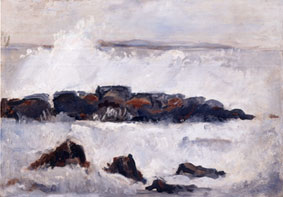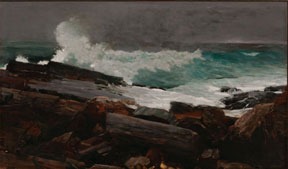 Not only did I see a play in Maine last week, but I made a point of paying a visit to the Portland Museum of Art. Though the museum’s permanent collection is always worth a look, I went there specifically to look at two exhibitions, “American Moderns: Masterworks on Paper from the Wadsworth Atheneum Museum of Art” and “Winslow Homer and the Poetics of Place.” Both are exceptionally fine, and the second show inspired me to write a “Sightings” column for Saturday’s Journal.
Not only did I see a play in Maine last week, but I made a point of paying a visit to the Portland Museum of Art. Though the museum’s permanent collection is always worth a look, I went there specifically to look at two exhibitions, “American Moderns: Masterworks on Paper from the Wadsworth Atheneum Museum of Art” and “Winslow Homer and the Poetics of Place.” Both are exceptionally fine, and the second show inspired me to write a “Sightings” column for Saturday’s Journal.
It happens that many of America’s finest artists, including Homer, Marsden Hartley, Edward Hopper, Alex Katz, John Marin, Fairfield Porter, and Neil Welliver, either lived in Maine or spent a considerable amount of time there. You can’t spend five minutes driving down the road without seeing why. I suppose there might be more picturesque places in America, but I can’t think of anywhere that offers more concentrated opportunities in a smaller geographical space to a representational artist.
 What struck me about the Winslow Homer show was the way in which it dramatizes how profoundly affected Homer was by the Maine seascape. This is, of course, a commonplace–everybody who knows anything about Homer knows how frequently he painted the coast of Maine–but to actually see a painting like “Weatherbeaten” in Maine is to be reminded with freshly illuminating force of this well-known fact.
What struck me about the Winslow Homer show was the way in which it dramatizes how profoundly affected Homer was by the Maine seascape. This is, of course, a commonplace–everybody who knows anything about Homer knows how frequently he painted the coast of Maine–but to actually see a painting like “Weatherbeaten” in Maine is to be reminded with freshly illuminating force of this well-known fact.
How did the experience of seeing “Weatherbeaten” and Marsden Hartley’s “Surf on Reef” at the Portland Museum of Art affect an art lover who, like me, was raised on twentieth-century abstraction? To find out, pick up a copy of Saturday’s paper and see what I have to say.
UPDATE: Read the whole thing here.
Terry Teachout on the arts in New York City
An ArtsJournal Blog
